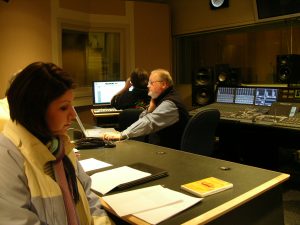
Creative Commons Image Obtained through Flickr
Essay by Timothy N. Osment
History M.A.
WCU 2008
The widespread poverty that the Great Depression brought to Appalachia led to the founding of one of the area’s most valuable treasures: the Penland School of Crafts. Nestled deep in the hills of western North Carolina’s Mitchell County is the small community of Penland. It was there that, in 1923, a young school teacher named Lucy Morgan noticed the desperate living conditions of many of her students and their families and felt compelled to provide assistance. She had spent a recent vacation at Berea College learning to weave. Unlike the heavy looms common in the mountains of North Carolina, Berea used light-weight Swedish looms that were easy to operate and created delicate patterns. Returning to North Carolina, Morgan gathered together a group of local women and began to instruct them in her newly-discovered passion: weaving. The women decided to call themselves the Penland Weavers.
Lucy Morgan was determined to find a market for the goods her weavers produced. She began to distribute their weavings throughout the region
One of the country’s leading experts on handweaving, Edward Worst, visited Penland during the summer of 1928. He published articles from his trip in a national magazine, contributing to the school’s reputation and significance. This exposure prompted additional growth.
During the 1930s Penland continued to develop. Edward Worst joined a growing list of notable craftsmen and craftswomen associated with the school. Emma Conley demonstrated for students how to pick marigold, pokeberries, walnuts, and smartweed and turn them into brilliant dyes. In her booklet, entitled Vegetable Dying, Conley recorded her recipes for deep yellows, reds, browns, and purples. Adding to her legend was her misspelling of the word “Dyeing” which is a part of Penland folklore to this day. Another interesting individual was Aunt Cumi Woody. During her entire life Aunt Cumi, a wise, elderly mountain woman, had spun and woven everything in her family’s house, including their linens and clothes. For many years she shared that knowledge with hundreds of Penland students. She demonstrated how to shear sheep, spin yarn,
In 1933 Lucy Morgan took a considerable gamble. She packed up her weavers and their wares into two mobile trailers and headed to the World’s Fair in Chicago. She need not have worried. Penland’s crafts were so popular that the school received immediate recognition and generated a profit before returning back to the mountains. Penland’s fame was spreading. Students began to request instruction in various crafts other than weaving. Morgan had little difficulty locating experts eager to share their knowledge and passion. Classes in basketry, leather-tooling, pottery, and wood-carving were added first. By 1934 metal and
No one imagined when Worst first visited the school in 1928 that he would teach there every summer until his death in 1949. Another historical addition was made possible by Lily Mills, a longtime supporter of the School. In 1947, when she noticed Penland turning students away due to a shortage of educational facilities, she donated $20,000 for a new building. The result was the Lily Loom House. Penland now includes over 40 structures on almost 400 acres. Penland’s mission statement proclaims the school’s goal of “enriching the lives of individuals by teaching skills, stimulating ideas, and promoting the value of craft in the world.” Over 1200 students learn at Penland every year.
Classes, designed by the instructors, usually include a mix of demonstrations, lectures, and studio work.
Penland also offers three-year residencies to artists, providing a stimulating environment for many who are at a transitional point in their careers. Visitors are welcome at Penland and can view and purchase the work of instructors, resident artists, students, and
Below is the Digital Heritage Moment as broadcast on the radio:
[audio:http://dh.wcu.edu/wp-content/uploads/2010/08/Pnlnd-60-mix.mp3|titles=Pnlnd 60 mix]
Penland School of crafts essay
contact information
- Penland School of Crafts P.O. Box 37 67 Doras Trail Penland, NC 28765 828-765-2359 office@penland.org
for more information
- Gift from the Hills; Miss Lucy Morgan’s Story of her Unique Penland School Lucy Morgan and Legette Blythe, 1958
- The Nature of Craft and the Penland Experience, Jean W. McLaughlin, ed., 2004
- The Story of the Penland Weavers, Bonnie Willis Ford, 1941
- The Craft Heritage Trails of Western North Carolina, Jay Fields, 2003
- Weavers of the Southern Highlands by Philis Alvic, 2003

